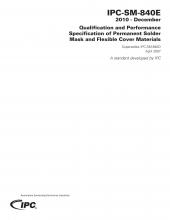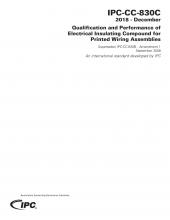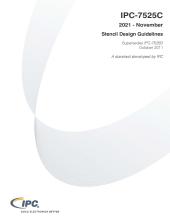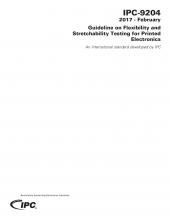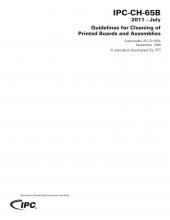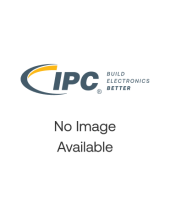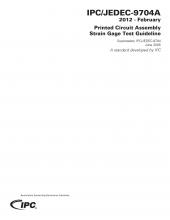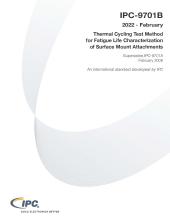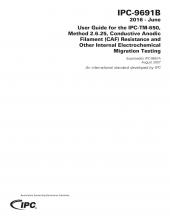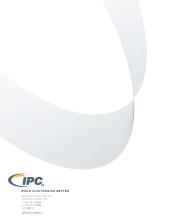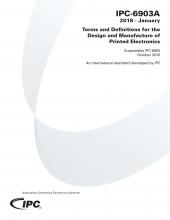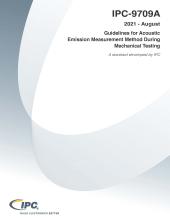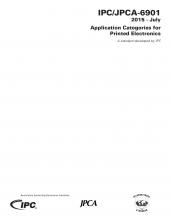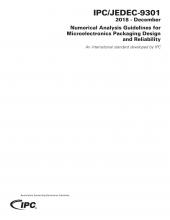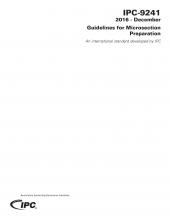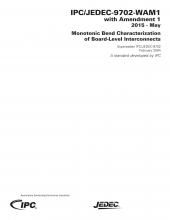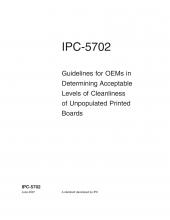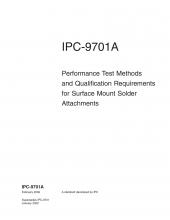Products
Establishes the requirements for the evaluation of liquid and dry film solder mask material and for the determination of the acceptability of use on a standard printed board system. IPC-SM-840 provides two classes of requirements, T and H, to reflect functional performance requirements and testing severity based on industry/end use requirements. Coverage is given to adhesion, material qualification...
The IPC-CC-830C standard establishes qualification and conformance requirements for electrical insulating compounds (conformal coatings). It has been designed and constructed with the intent of obtaining maximum confidence in the materials with minimum test redundancy. The IPC-CC-830C standard covers: • The qualification and qualification retention of the conformal coating material (Table 3-1...
The IPC-7525C standard provides guidance for the design and fabrication of stencils for solder paste and surface-mount adhesive with much of the content based on the experience of stencil designers, fabricators, and users.
This guideline describes flexibility and stretchability testing to evaluate printable electronics for stretchable and wearable applications. 26 pages. Released March 2017
This document includes lead free, no-clean, and environmental friendly chemistries. This is a collection of information on electronic board and assembly cleaning in a single location. This major revision explains the relationship between materials, processes, and contaminants in fabrication and assembly operations. It also addresses cleanliness assessment and process control in relation to...
While there are a variety of industry test vehicles for the examination of material compatibility, the IPC-B-52 test board was created to meet the needs for testing both ion chromatograph and surface insulation resistance (SIR) which would be more representative of the manufacturing materials and processes. IPC-9203A standard addresses the IPC-B-52 test vehicle, which can be used to evaluate a...
Strain gage testing allows for objective analysis of the strain and strain rate levels to which a surface mount package may be subjected to during assembly, test and operation. Excessive strain can result in various failure modes for different solder alloys, package types, surface finishes or laminate materials. This document describes specific guidelines for strain gage testing during the printed...
The IPC-9701B standard establishes a thermal cycling test method to characterize the fatigue lifetimes of surface mount solder attachments of electronic assemblies. The surface mount devices may be solder-attached to rigid, flexible or rigid-flex printed boards. The characterization results can be used to predict the field lifetime of solder attachments for the use environments and conditions of...
This document is the product of the IPC Electrochemical Migration (ECM) Task Group. It was drafted to provide guidance regarding implementation of the User Guide for the IPC-TM-650, Method 2.6.25, Conductive Anodic Filament (CAF) Resistance and Other Internal Electrochemical Migration Testing to evaluate the effects of mechanical stress, laminate material fracturing, ionic contamination, moisture...
The IPC-9202A, Material and Process Characterization/Qualification Test Protocol that records changes in Surface Insulation Resistance (SIR) on a representative sample of a printed circuit assembly (PCA). It quantifies any deleterious effects that might arise from solder flux or other process residues left on external surfaces after soldering, which can cause unwanted electro-chemical reactions...
The IPC-6903A standard provides 62 additional terms and definitions for the design and manufacture of printed electronics. The IPC-6903A standard creates a common language and understanding for the worldwide printed electronics community.
The IPC-9709A standard guideline document establishes an Acoustic Emission (AE) method to enhance evaluation of the performance and reliability of surface mount attachments of electronic assemblies during mechanical loading.
Contains over 150 industry approved test techniques and procedures for chemical, mechanical, electrical, and environmental tests on all forms of printed boards and connectors. New and updated test methods are available for download at https://www.ipc.org/test-methods.
Establishes mechanical drop and shock and test guidelines for assessing solder joint reliability of printed board assemblies from system to component level. This document addresses methods to define mechanical shock use-conditions, methods to define system level, system printed board level and component test board level testing that correlate to such use conditions and guidance on the use of...
This standard establishes a Market Classification System and Level Classification System for printed electronics assemblies and provides a list of performance criteria and testing methods. It provides a standardized product category structure for designing and manufacturing printed electronics and assemblies which conform to industry-established performance metrics as determined by accepted...
The IPC/JEDEC-9301document is an effort to standardize and document some of the basic tenets of a typical Finite Element Analysis (FEA) model, as well as, to educate new designers (and in some cases even experienced designers) on the basic information and best practices that should be captured and provided to technical reviewers of the results of FEA data.
This standard is intended as a guideline in the proper preparation of a metallographic sample (microsection) of a printed board. The finished microsection is used for evaluating the quality of the laminate system and plated structures (e.g. PTHs and vias). Microsection sample preparation is regarded by many as a highly developed skill. The guidelines in this standard discuss the many variables and...
Mechanical bend and shock tests are routinely performed on SMT assemblies to ensure that they can sustain anticipated production, handling and end use conditions. The strains and strain rates applied to SMT assemblies during bend and shock testing can lead to a variety of failure modes in the vicinity of the solder joints. This document provides test methods to evaluate the susceptibility of...
Provides information on design characteristics and the application of solderless surface mount connectors, including conductive adhesives to aid IC package and board interconnection. 34 pages. Released January 1994.
Establishes the requirements for the evaluation of liquid and dry film solder mask material and for the determination of the acceptability of use on a standard printed board system. IPC-SM-840 provides two classes of requirements, T and H, to reflect functional performance requirements and testing severity based on industry/end use requirements. Coverage is given to adhesion, material qualification...
This standard provides industry-approved terms and definitions to create a common language for users and suppliers to develop electronics products that utilize printed electronics alone or as additive processes combined with traditional rigid, flexible and rigid-flex PWB assemblies Released October 2015.
This publication is intended to characterize the frature strength of a component's board level-interconnect by providing a common method of establishing the fracture resistance to flexural loading that may occur during conventional non-cyclic board assembly and test operations. The document is applicable to surface mount components attached to printed wiring boards using conventional solder reflow...
Survey-based study presents data and analysis on the EMS industry, examining trends in sources of revenue, revenue per employee, services offered, markets served, manufacturing technology, capital investment, spending on equipment and materials and market size including forecasts and potential for market expansion. This study is based on data provided by a representative sample of 120 EMS...
Every electronics manufacturer, whether an original equipment manufacturer (OEM) or electronics manufacturing services (EMS) company, must determine if the unpopulated printed boards entering the assembly process have an adequate level of cleanliness. The question of “how clean is clean enough?” is one that has no definitive answer, as there is no "golden number" for board cleanliness. The issue...
Provides specific test methods to evaluate the performance and reliability of surface mount solder attachments of electronic assemblies. Establishes levels of performance and reliability of the solder attachments of surface mount devices to rigid, flexible and rigid-flex circuit structures. When used with IPC-SM-785, it provides an understanding of the physics of SMT solder joint failure and an...
Coming Soon
IPC-7095E: Design and Assembly Process Implementation for Ball Grid Arrays (BGAs)
IPC-7530B: Guidelines for Temperature Profiling for Mass Soldering Processes (Reflow & Wave)
IPC-2294: Design Standard for Printed Electronics on Rigid Substrates
IPC-6904: Qualification and Performance Specifications for Printed Electronics on Rigid Substrates
IPC-4105: Specification for Metal Base Copper Clad laminates for Rigid Printed Boards

